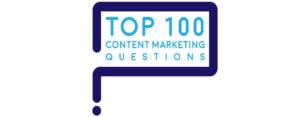
“How do you measure meaningful web traffic?”
How do you measure meaningful web traffic? Analytics is Key
“And how can you give the content credit?”
A marketer from Texas Instruments asked this question, which ranks among the Top 100 Questions on content marketing.
The most meaningful web traffic comes from potential customers who need answers, seek authoritative content, and find exactly what they need on your website.
Get a pure read on content marketing performance
Most websites have many different types of pages, and each does a different job. Some pages offer content or information, others enable transactions, and other pages sell.
Measure content pages separately from the other webpages on your site – to get a pure read on the jobs content gets done for you.
In your analytics platform, filter out transactional and other pages to focus on web traffic to content pages.
Find the answers you need

In your analytics platform, look for answers to these 4 key questions:
Which content pages do people visit most? What pages have the highest web traffic?
On most websites, a very small percentage of content pages drives most traffic. Keep track of your top-performing content pages – the 5, 10 or 20 pages that bring half or more of your content webpage traffic.
Refresh these top content pages often. Add new news, links to new posts, and different types of media.
For example, if your content is mostly text, create infographics, videos or podcasts to draw more people in.
How do people find your content? Where does your audience come from?
Different audiences behave differently, so there is no one-size-fits all approach to take. How people find you all depends on your specific audiences’ behaviors.
Many brands find that most of their web traffic comes from search or social media (paid or organic). Advertising, email, news media, event coverage, and backlinks from other sites may rank among your key traffic sources.
Most marketers create new content, distribute it and move on, before directing enough attention to the existing content that readers may not have seen. Boost the findability of your content by consistently promoting it after its initial distribution, as Heidi Cohen advocates.
Where do people go after consuming your top content pages?
A smart webmaster always used to ask me, “After they see this content, what exactly do you want them to do?” A great question you should always ask.
Ideally, each content webpage will suggest a related piece of content on the same topic or for the same audience. For example, make it easy for readers who just finished a blog to find a relevant, related video.
Never leave people guessing where to go next. Instead, minimize friction. Direct readers to a page where all the related content about a topic is bundled together.
People worry about bounce rates – perhaps excessively. The average website bounce rate is about 61%, Andy Crestodina found. “The one-page visit is just the reality of the internet,” he says.
To see whether a one-page visit is positive, look at the time on page along with the bounce rate. When readers find what they need on one page, it’s ok. Job done.
Where do people go after consuming your top-performing content? Does content lead to conversion?
Use goal completions to measure how often your audience does what you’d want them to do next on your website. Assign a value to completions, even if it’s an arbitrary amount like $1.
For example: how often do website users consume more than one page of content, view your contact information, spend more than X minutes on your site, or sign up for a blog? Each of those behaviors has value.
These behaviors are what I call “soft conversions,” because you asked readers to do something small, and they said yes.
A bigger ask is for a buyer to provide contact information in exchange for a download or virtual event. These are “hard conversions.”
Generally, soft conversions foreshadow hard conversions.
If you can increase the number of soft conversions, hard conversions go up too.
Ultimately, you want people who consume content to contact sales about buying, or make a purchase through the website. When you answer all of buyers’ questions first with great content, it becomes much easier to make the sale.
Here’s a related piece of content for you: How should you set up your content marketing analytics?

“How do you measure meaningful web traffic? And how can you give the content credit?” is one of marketers Top 100 Questions on content marketing. Here are the answers.





